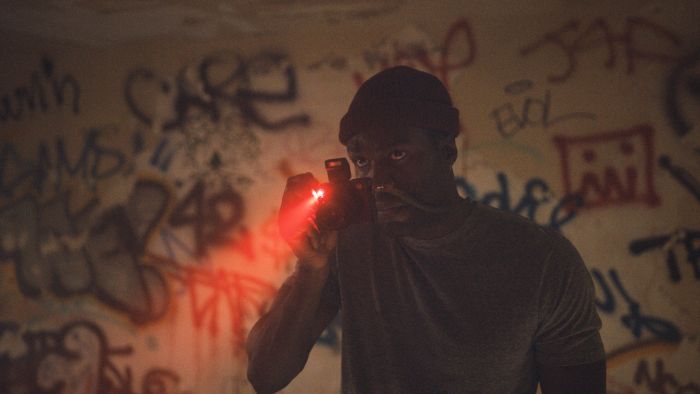Say my name, say my name
Anthony McCoy (Yahya Abdul-Mateen II) lives a comfortable life with his beloved Brianna (Teyonah Parris) in one of Chicago’s trendy neighborhoods. He – a young painter, discovered by art dealers and critics while still studying at a prestigious academy, she – an ambitious art curator. His initial success and controversial topics (Tony deals with the issues of violence and interracial friction in his work) ensured him publicity and financial comfort, but they effectively distracted him from creating – he had not painted anything for two years. In search of inspiration, the artist discovers an urban legend associated with the abandoned Cabrini-Green district. The myth about a murderer with a hook, luring his victims with sweets, appearing in the mirror when summoned five times, stimulates the painter’s imagination, who begins to feel a certain bond with the haunted place.

Tell everyone
Genre cinema is considered by many to be empty entertainment, the inferior child of the 10th muse, and horror – as the most burdened with formal patterns and clichés – as the least valuable genre. From the dawn of the medium, the authors have been reminding malcontents about how damaging this thesis, and works like Nosferatu – symphonies of horror , Doctor Caligari’s Office , Night of the Living Dead or a cross-section of works by Wes Craven, David Cronenberg and John Carpenter have found their way into the canon of world cinema. In recent years, however, the trend of creating an openly socially engaged horror has intensified, in which the Monkeypaw Productions studio founded by Jordan Peele has specialized. Previous storylines of the creator – Run away! and it’s us– they took on the wallpaper the issues of constantly deepening social inequalities and pointed the faces of contemporary racism. Compared to Candyman, who is just entering the screens , this criticism, focused on the hypocrisy of progressive and liberal circles, may seem like a rather benevolent smack.
This time, Peele gave the director’s stool to the young Nia DaCosta with age and achievements, while remaining the producer and co-writer (along with his regular collaborator – Win Rosenfeld – and DaCosta). Thanks to this, the traces, motifs and observations also present in the above-mentioned titles gain fresh energy – it is an angry, furious and painful cinema, at the same time accusatory and cathartic. It is a scream of despair and helplessness against the violent system that creates excluded groups from the top and then can fight them for show – which in the case of black people in the USA is also a trace of history written in the blood of their ancestors, and (as shown by cyclical protests in response to reports about subsequent cases of abuse of uniformed services) everyday gray matter.
Where Peele has so far ironized and ridiculed, DaCosta settles without compromise and leniency, not playing with subtlety and veiling the message. For this is – and has always been – the Candyman figure: a mulch created to tame the collective trauma inherited by successive generations of African Americans experiencing violence. A reproach of collective conscience. A tragic figure – his subsequent incarnations, bees in his “hive”, are victims of senseless violence, lynchings, false accusations. The Candyman name is a curse triggered by deeply entrenched and still present injustice and systemic oppression. An oppression that has real consequences and affects everyone – even those who (yes,

Racial horror
This does not mean that Candyman is devoid of Peele’s lightness and irony. The more severe offenses of the system are scored with an appropriate accent, but relatively lighter – such as the appropriation of black art and the appropriation of the narrative by dominant groups personified in the form of a cynical art dealer and blasé white critic – are summed up with perverse jokes. The time will probably come for their settlement.
The political overtone of the film might not sound as strong, and even smell of didacticism, if Candyman was not also an effective, brilliantly realized horror film. The creators know the rules of the game very well and use them to construct an engaging, disturbing story, illustrated with photos by John Guleserian and an atmospheric soundtrack composed by Robert AA Lowe, in addition to the clear message. The painting does not avoid gore and body horror elements, but more often it resort to the distancing treatment – presenting particularly brutal stories in the form of children’s play, paper shadow theater. Then we have to imagine the greatest atrocities ourselves …

